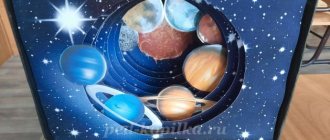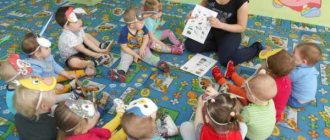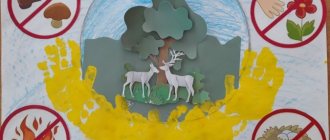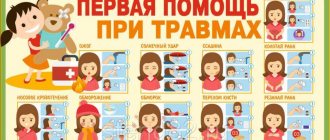MAGAZINE Preschooler.RF
Project activity “DIY children’s themed books”Completed by: Teacher-speech therapist Smirnova I.A. r.p. Tonkino 2022 Municipal budgetary preschool educational institution kindergarten No. 5 “Fairy Tale”
Relevance:
Fiction in the light of the Federal State Educational Standard for Pre-Speech Development includes... acquaintance with book culture, children's literature, listening comprehension of texts of various genres of children's literature... (clause 2.6 of the Federal State Educational Standard for Preliminary Education). ARTISTIC AND AESTHETIC DEVELOPMENT involves the development of prerequisites for value-semantic perception and understanding... of fiction, folklore; stimulating empathy for characters in works of art (clause 2.6 of the Federal State Educational Standard for Education).
Nowadays, children have reduced interest in fiction.
How to introduce a child to reading? Many will consider that in our age, the age of development of computer and other technical technologies, it is irrelevant to talk about books and reading.
A book can enter a child’s world as early as possible, enrich this world, make it interesting, full of extraordinary discoveries. The child will love the book and reach for it if there is motivation and interest. Books have a special charm, books bring us pleasure, they talk to us, give us good advice, they become living friends for us.
The urgency of solving this problem is obvious. To develop a reader in a child, an adult must himself show interest in a book, understand its role in a person’s life, know the books recommended for preschool children, be able to have an interesting conversation with children and help in analyzing the work.
Problem:
Waning interest in fiction.
Goal: To develop interest in fiction in children of middle preschool age.
Tasks:
- To form in children an understanding that a book is a source of knowledge.
- Cultivate interest in books and a caring attitude towards them.
- Arouse positive emotions when reading books.
- Encourage parents to engage in joint productive activities.
Type: informational - educational, creative.
Duration: short term
Participants: middle school children, teachers, parents, speech therapist.
Expected result:
- Increasing children's interest in reading and fiction.
- Enrichment of vocabulary, development of lexical and grammatical structure, coherent speech of children.
- Increasing the level of children's speech development.
- Active participation of parents in the life of the kindergarten.
- Positive attitude of parents in joint activities with teachers.
- Revival of reading in the family circle.
Stages of work on project activities:
Stage 1: Organizational
- Determining the theme of the project.
- Formulation of goals and objectives. Familiarizing children and parents with the goals and objectives of the project.
- Drawing up a plan for the main stage of the project. Selection of material. Survey of children.
- Selection of didactic and methodological equipment for the project.
- Decision making: implementation of the “Do it yourself book”
Stage 2: Practical
- Speech development: “The Tale of the Wise Mother Earth and her three assistants (Droplet, Ray and Svetik) .
- Cognition: “Water” , “How books are born” .
- Construction of a “Little book with your own hands” .
- Application: Compiling a book “Spring” , “Water” .
- Reviewing different books of different types and genres.
- Conversations: “Take care of the book” , “Why are books needed” , “Where do books live? ”
- Role-playing game "Library" .
- Speech game “Which one, which one” ,
- Didactic game: “Moneybox of new words” , “Guess the riddle” , “Choose a word” , “One, two, three, turn the picture and tell us .
- Productive activity: game “Treating a book”
- Joint creativity: “In a fairy-tale world” (writing fairy tales about water, etc.).
Stage 3: Final
- During the implementation of the project, all points of the plan are carried out step by step, the results are analyzed
- collecting the received material for the project,
- project implementation report.
Implementation of project activities:
- Directly educational activities.
- Joint activities of teachers and children;
- Work of teachers with parents;
- Creation of a subject-development environment.
- Joint free activities of children and parents.
Forms and methods of work
Homework for children and parents: create a little book on the lexical topics covered" "My favorite book"
Collective production of the book “Seasons” .
In addition to practicing lexical topics, practice the ability to identify the first and last sound, first and last letter in a word, the ability to determine the number of syllables in words, and compose not only sentences with given words, but also stories.
Collective design of a book, where each child has his own page, or joint production of a book for each child with an adult.
During the work on the project, we came to the conclusion that such activities, games, and productive activities unite children with common impressions, experiences, emotions, and contribute to the formation of collective relationships. We really hope that the work we do will help children fall in love with books and instill in children a desire to read and make books themselves and write stories.
What is “good” about a homemade book?
- A homemade book is a product of a child’s creative efforts, designed to instill respect for one’s own and others’ creativity.
- A homemade book is a great opportunity for children and adults to communicate and create something smart, beautiful and useful together.
- In the process of making a book, the child’s speech, creative thinking and fine motor skills develop.
| Next > |
Design options for a children's book
When creating a children's book, little ones can safely fantasize and experiment, since such a book does not provide for absolutely any restrictions in design or theme.
If nothing comes to mind, then you can check out the list of the most popular options for homemade children's books, which may serve as a good source of inspiration for creating something unusual and original:
- Sketchbook book;
- A book made of stitched sheets of colored cardboard;
- Soft educational book made of fabric;
- A book with photographs;
- Coloring book with riddles;
- Baby's personal diary;
- A book with fairy tales and poems.
When choosing any design option, you should not be afraid to experiment, combining several ideas into one. For example, you can make a soft personal diary or an educational fairy tale book for your child! The more interesting and brighter the book is, the more delight it will cause in the child!
History and development of the book
The history of the book has its roots in the distant past. Different peoples came to writing in different ways, using different materials for writing: stone, bone, wood, metal, silk, leather, corn stalks.
The word
book comes from the Church Slavonic expression “knigi”, which means letters or writing in general.
In ancient times, stone was used as a writing material. The first drawings by primitive artists were found on the walls of caves. Subsequently, laws, names of kings, and memorable events were carved on rocks, stone tiles and pillars. Clay books are the most ancient. On the still soft and wet clay, words-icons were squeezed out with a sharp stick. Then the board was dried and fired in ovens, like pots. The clay tiles were 32x32 cm in size and 2.5 cm thick - real flat bricks. A book was created from a dozen, and sometimes hundreds of such pages. Such books were written in the ancient states of Mesopotamia and Assyria.
And in the neighboring Egyptian state, books were made from papyrus - a river reed with a tall and thick trunk, cut into strips and dried. They wrote on them with sticks, dipping them in ink or colored paints. Then the sheets were glued together to form a book in the form of a long scroll, usually about 6 meters long. After reading, the scroll was rolled into a tube and stored in a special case.
People have used papyrus for many centuries. Egyptian, Jewish, Greek, Persian papyri have reached us, which are stored in the largest museums in the world. The British Museum in London contains papyrus 40 meters long, but there were also scrolls 45 meters long. A scroll is one continuous page.
The scrolls contain historical documents, scientific works, and literary works of the peoples of the Ancient East, Greece and Rome. Papyrus was replaced by a new writing material - parchment. In the ancient Pergamon state, it was made from animal skins (goats and sheep, and the thinnest was obtained from calf skin).
It could be written on both sides. A sheet of parchment was folded in half to make four pages. The quarter in Greek was called “tetrados”, and all together they made up a notebook. Several of these notebooks were stitched together to form a book in which one could write and draw, and it was called a codex. In appearance, the codex resembles a modern book.
It took a whole flock of sheep to write one book. The book was written by hand over several years. Papyrus and parchment were expensive. And the copying of books itself was expensive, because there were few learned people who could copy correctly. Therefore, they wrote only the most important messages that needed to be saved for a long time. For everyday use, they used tablets on which they could destroy what was written.
Sometimes the tablets were covered with a thin layer of wax and written with a thin point. When the recording became unnecessary, the wax was heated, it melted and the recording was erased; when the wax hardened, you could write again
In Ancient Russia they wrote on birch bark - birch bark. Marks were made on the bark using a bone rod with an eye at the top, through which a ribbon was pulled. The rod was hung from the belt. In the 2nd century AD. Paper was invented in China. It was cheaper material. Paper was invented by Cai Lun. He found a way to make paper from the fibrous inner bark of the mulberry tree.
The Chinese learned to grind the bark in water to separate the fibers, then they poured the mixture onto trays with long, narrow strips of bamboo at the bottom. When the water drained, the soft sheets were laid to dry on a flat surface. On March 1, 1564, the first Russian printed book “Apostle” appeared. Later he created the first Slavic “ABC” and a new edition of “Apostle” in Lvov.
In 1580-81 published the first complete Slavic Bible (“Ostrog Bible”). Books are interesting not only for their content. There are publications of different formats, shapes, colors and even composition. For example: a book that can be held only with the pads of your fingers, a book similar to tennis balls made of the same material, a folding book, a wooden book with an unusual, convex cover.
There is even a sculpture in the form of a book in St. Petersburg. Pushkin’s lines “I love you, Peter’s creation...” are carved on it. The twentieth century gave us a new type of book - electronic. This book is stored in the computer's memory. It can accommodate not thousands, but tens of thousands and even millions of works. By the way, the electronic book and the traditional one do not compete with each other, but coexist peacefully.
And this is not surprising. After all, a multi-volume encyclopedia can fit on a small CD, instead of taking up an entire shelf of a bookcase. However, most of the books we need are better to have in print; unlike a computer, they do not require electricity, and they can be taken anywhere.
So, the first conclusion that I came to while working on this topic of the literary reading project in 2nd grade is that a book is an invaluable heritage , because books are the main guardians and witnesses of human history. No matter how the world around us changes, no matter how time rushes forward, changing the way of life and the faces of rulers, the book always remains close to a person, gives him information, calms and encourages him in difficult times, nourishes him with hope and inspires.







